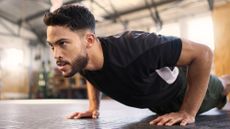Burn fat in 12 minutes with this high-energy Tabata workout
This 12-minute no-equipment Tabata workout will burn fat and boost your fitness, according to research


When it comes to fitting a lot of fat-burning exercise in a short space of time, Tabata is top of the list. A type of high-intensity interval training, Tabata simply means picking an exercise, performing it for 20 seconds, resting for 10 seconds, then picking a different one. Rinse and repeat for four, eight or 12 minutes.
Often done with the best exercises for weight loss, like burpees, or the best workouts for abs, like crunches, Tabata has been found to be extremely effective when it comes to getting fit losing weight and burning fat.
Created by sports scientist Izumi Tabata, his peer-reviewed paper published in the Journal of Physiological Sciences found that six weeks of Tabata intervals offered fitness benefits (measured by VO2 max improvements) comparable to HIIT and other moderate-intensity aerobic training programs.
The difference is that Tabata training is over and done with extremely quickly, making it more efficient at improving your fitness in a short space of time.
It's also great for burning fat. A paper by researchers from the Budi Utomo Institute found "Tabata training method represents an effective way in reducing body weight and body fat... That's because tabata training requires more energy, so that more fat burning occurs."
So, want to get fit in under 15 minutes a day? This 12-minute routine from Anna Engelschall, better known online as Growingannanas, is a great place to start.
Watch the Tabata workout below
Described as a "HIIT mood booster" workout, this workout contains no repeating moves and needs no equipment to get started. It's also set to high-tempo, high-energy pop covers guaranteed to keep you moving.
Get the Fit&Well Newsletter
Start your week with achievable workout ideas, health tips and wellbeing advice in your inbox.
It does contain jumping moves such as lunges and high knees, so it's not for those looking for a low-impact workout, but this jumping does serve a purpose. These "plyometric" exercises have a whole host of benefits, according to a paper published in the International Journal of Sports Physical Therapy.
These benefits include "the ability to increase average power and velocity; increased peak force and velocity of acceleration; increased time for force development; the ability for heightened levels of muscle activation; and the ability to evoke stretch reflexes."
Finding this workout a little challenging? You might benefit from slowing things down and focusing on form: check out our guides on how to do lunges and how to do squats for more information. Alternatively, if you're finding it too easy, you can loop one of the best resistance bands around your legs while you squat to increase the tension.
Matt Evans is an experienced health and fitness journalist and is currently Fitness and Wellbeing Editor at TechRadar, covering all things exercise and nutrition on Fit&Well's tech-focused sister site. Matt originally discovered exercise through martial arts: he holds a black belt in Karate and remains a keen runner, gym-goer, and infrequent yogi. His top fitness tip? Stretch.
-
 I struggled to achieve full range of motion in my hips until I tried this one hip-loosening stretch for five minutes a day
I struggled to achieve full range of motion in my hips until I tried this one hip-loosening stretch for five minutes a dayStretching Can a stretch be life-changing? This hip stretch certainly was for me
By Lou Mudge Published
-
 Forget push-ups—try this trainer’s bodyweight alternative to develop your strength and mobility
Forget push-ups—try this trainer’s bodyweight alternative to develop your strength and mobilityWorkout The beast push-up can help you build functional strength and protect yourself from injury, whatever your fitness level
By Harry Bullmore Published